Costoclavicular Syndrome
What is a Costoclavicular Syndrome?
Costoclavicular Syndrome, also known as Thoracic Outlet Syndrome (TOS), is a medical condition characterized by the compression of nerves, blood vessels, or both in the thoracic outlet. The thoracic outlet refers to the space between the clavicle (collarbone) and the first rib, through which important structures such as nerves and blood vessels pass as they travel from the neck to the arm.
- The costoclavicular syndrome is one of 3 passages that form the thoracic outlet syndrome, others are the superior thoracic outlet and costoscalene hiatus. The costoclavicular canal is formed by the clavicle anterolaterally, the first rib medial side, and the scapula posterior side. The brachial plexus, subclavian artery, and subclavian vein pass in the costoclavicular space connecting the first rib and the clavicle. In this condition, the neurovascular bundle is compressed.
Mechanism of Costoclavicular Syndrome
Costoclavicular syndrome was first described in soldiers with loaded backpacks who developed pain, numbness, and fatigue in their hands while on alert(attention). Compression mechanisms involved the downward movement(activity) of the clavicle against the first rib, resulting in a tendency to cut the neurovascular bundle.
This can happen in three ways:
- The clavicle is pushed to/against the first rib. This can be seen in general posture where the shoulders are rounded and slumped. This narrows the costoclavicular passage, pushing the scapula forward.
- It can also be caused by a tight subclavian. A similar mechanism is usually at work in obese, middle-aged, or elderly women. Tight, narrow brassiere straps that provide heavy breasts cut into the soft tissue around the shoulders muscles and apply direct downward pressure to the collarbone, usually at the junction of the middle and lateral thirds. The scissoring action of the clavicle against the first rib narrows the costoclavicular passage and cuts the nerve bundle.
- The first rib rises towards/against the clavicle. This often happens to clients with breathing problems. It can also be caused by tight front and middle scales and subclavius.
- The clavicle depresses and the first rib raise.
Cause of Costoclavicular Syndrome
- Poor posture: Slouching or maintaining a forward head posture can contribute to the compression of nerves and blood vessels in the thoracic outlet, leading to symptoms of costoclavicular syndrome.
- Trauma: A previous injury, such as a shoulder dislocation, collarbone fracture, or whiplash injury, can cause structural changes in the thoracic outlet area, resulting in compression or irritation of nerves or blood vessels.
- Anatomical abnormalities: Some individuals may have naturally occurring anatomical variations that predispose them to thoracic outlet compression. These abnormalities can include cervical ribs (extra ribs near the neck), abnormal muscle development, or a narrow thoracic outlet.
- Repetitive activities: Repeated and prolonged activities that involve overhead arm movements, such as certain sports (e.g., swimming, baseball) or job-related tasks (e.g., lifting heavy objects, repetitive computer use), can put stress on the structures in the thoracic outlet, leading to compression or irritation.
- Muscle imbalances: Imbalances in the muscles surrounding the shoulder girdle and neck can alter the position and stability of the structures in the thoracic outlet, potentially causing compression of nerves and blood vessels.
- Tumors or masses: Rarely, tumors or abnormal growths in the thoracic outlet region, such as a cervical rib tumor or an enlarged blood vessel, can compress the nerves or blood vessels and contribute to costoclavicular syndrome.
Symptoms of the Costoclavicular Syndrome
- Pain or discomfort in the neck, shoulder, and arm: This pain is typically described as a dull ache or a sharp, shooting pain that may radiate down the arm. The pain may worsen with certain activities or positions, such as lifting heavy objects or reaching overhead.
- Numbness or tingling: You may experience numbness, tingling, or a pins-and-needles sensation in the affected arm or hand. This can occur along the inner side of the forearm, the ring and little fingers, or the entire hand.
- Weakness: Weakness in the arm or hand may be present, making it difficult to grip objects or perform certain tasks.
- Swelling or discoloration: In some cases, swelling or discoloration (bluish or purplish) of the affected arm or hand may occur due to impaired circulation.
- Coldness or temperature sensitivity: The affected arm or hand may feel colder than the rest of the body or be more sensitive to changes in temperature.
- Muscle atrophy: Chronic compression of the nerves in the thoracic outlet can lead to muscle wasting or atrophy in the affected arm.
- Limited range of motion: You may experience a decreased range of motion in the neck, shoulder, or arm, making it challenging to perform certain movements.
- It’s important to note that these symptoms can vary depending on the underlying cause and the specific structures being compressed. If you suspect you may have costoclavicular syndrome, it is recommended to consult with a healthcare professional for an accurate diagnosis and appropriate treatment.
Diagnosis
- Medical history: Your healthcare provider will start by asking you about your symptoms, their duration, and any factors that worsen or alleviate them. They will also inquire about your medical history, previous injuries, and any activities or occupations that may contribute to the development of thoracic outlet syndrome.
- Physical examination: A thorough physical examination is performed to assess your range of motion, muscle strength, and sensation in the affected area. Your healthcare provider will examine your neck, shoulder, and arm, looking for signs of tenderness, swelling, or muscle atrophy. They may also evaluate the position and movement of your collarbone and ribs.
- Provocative tests: Your healthcare provider may perform specific maneuvers to reproduce or exacerbate your symptoms. These tests aim to provoke compression of the nerves or blood vessels in the thoracic outlet, helping to confirm the diagnosis. Examples of provocative tests include Adson’s test, Roos test, Wright test, and costoclavicular maneuver.
- Imaging tests: To visualize the structures in the thoracic outlet and identify any abnormalities or compression, imaging tests may be ordered. These can include:
- X-rays: X-rays can help assess the alignment and position of the bones in the neck and shoulder, and detect any abnormalities such as fractures or bony abnormalities that may contribute to the compression.
- Magnetic Resonance Imaging (MRI): MRI scans can provide detailed images of the soft tissues in the thoracic outlet, including the nerves, blood vessels, and muscles. This can help identify any structural abnormalities, such as herniated discs or tumors, causing the compression.
- Computed Tomography (CT) scan: CT scans can provide detailed cross-sectional images of the structures in the thoracic outlet, allowing for better visualization of bony abnormalities, such as bone spurs or tumors.
- Electromyography (EMG) and Nerve Conduction Studies (NCS): These tests measure the electrical activity and conduction of the nerves in the affected area. They can help determine the presence and severity of nerve compression or damage.
Differential Diagnosis
- Cervical radiculopathy: This condition involves compression or irritation of a nerve root in the cervical spine (neck). It can cause neck, shoulder, and arm pain, as well as numbness, tingling, and weakness. However, the symptoms are typically limited to a specific dermatome (area of skin innervated by a specific nerve root), whereas thoracic outlet syndrome may affect a broader distribution.
- Brachial plexopathy: The brachial plexus is a network of nerves that originates from the spinal cord in the neck and supplies the shoulder, arm, and hand. Injury or compression of the brachial plexus can result in similar symptoms to thoracic outlet syndrome, including pain, numbness, tingling, and weakness in the affected arm.
- Rotator cuff injury: Damage or inflammation of the tendons and muscles that stabilize the shoulder joint (rotator cuff) can cause pain and limited range of motion in the shoulder and arm. The symptoms may be aggravated by certain movements or activities, similar to thoracic outlet syndrome.
- Peripheral neuropathy: Peripheral neuropathy refers to damage or dysfunction of the peripheral nerves, typically in the extremities. It can cause symptoms such as pain, numbness, tingling, and weakness in the arms and hands. Diabetes, vitamin deficiencies, infections, and certain medications are common causes of peripheral neuropathy.
- Frozen shoulder (adhesive capsulitis): Frozen shoulder is a condition characterized by stiffness and pain in the shoulder joint, often following an injury or prolonged immobilization. The pain may radiate down the arm, and there can be limited range of motion, but it typically does not involve the neck or exhibit neurological symptoms.
- Vascular disorders: Conditions that affect the blood vessels, such as arterial or venous compression or thrombosis, can cause arm pain, swelling, discoloration, and temperature changes. These symptoms may resemble those of thoracic outlet syndrome, and proper evaluation is necessary to differentiate between the two.
Treatment for Costoclavicular Syndrome
Treatment for Costoclavicular Syndrome varies depending on the severity of symptoms and the underlying cause. Conservative approaches, such as physical therapy, posture correction, and activity modification, are often the first line of treatment. In more severe cases or when conservative methods do not provide sufficient relief, medical interventions, including medications, corticosteroid injections, or in some cases, surgery, may be recommended.
Early detection and appropriate management are essential to alleviate symptoms and prevent potential complications associated with Costoclavicular Syndrome. If you experience persistent shoulder, arm, or hand discomfort, it is crucial to seek medical attention promptly to receive an accurate diagnosis and tailored treatment plan.
Medical treatment
- Pain management: Over-the-counter nonsteroidal anti-inflammatory drugs (NSAIDs), such as ibuprofen or naproxen, can help relieve pain and reduce inflammation. In some cases, your healthcare provider may prescribe stronger pain medications or muscle relaxants to manage severe pain or muscle spasms.
- Injections: Corticosteroid injections may be used in cases of severe pain or inflammation to provide temporary relief. These injections are administered directly into the affected area to reduce inflammation and relieve symptoms.
Physiotherapy Treatment
- Physical therapy: Physical therapy plays a crucial role in the management of costoclavicular syndrome. It focuses on improving posture, strengthening the muscles around the shoulder and neck, and increasing flexibility. Therapeutic exercises, stretching techniques, and manual therapy can help relieve pain, improve range of motion, and correct any muscle imbalances.
- Posture correction: Proper posture is essential in reducing the compression on the nerves and blood vessels in the thoracic outlet. Ergonomic adjustments, such as adjusting your workspace or using proper lifting techniques, can help improve posture and minimize symptoms.
Scapular Retraction:
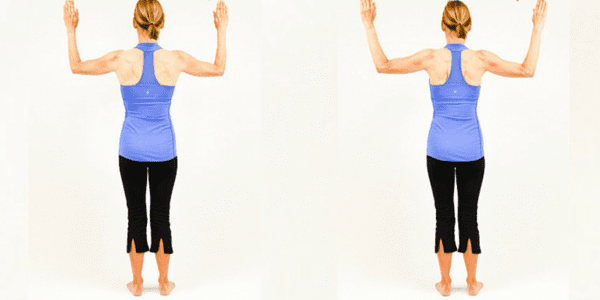
- Stand position or sit position upright with your arms by your sides.
- Gently squeeze your shoulder blades together, pulling them down and back.
- Hold the position for a few seconds, then relax the position.
- Repeat for 10-15 repetitions.
Shoulder Rolls:
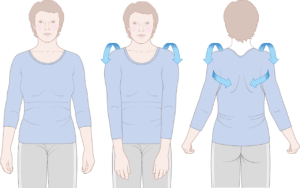
- Stand upright with keep your arms relaxed at your sides.
- Roll your shoulders forward side in a circular motion.
- Repeat for 10-15 repetitions, then reverse the direction and roll your shoulders backward for another 10-15 repetitions.
Neck Stretches:
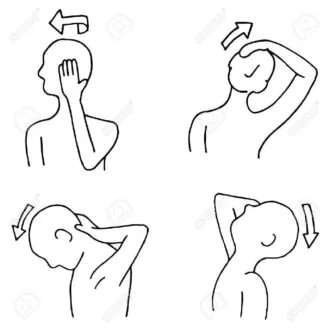
- Sit position or stand position upright with your shoulders relaxed.
- Tilt your head position to the right, bringing your right ear towards your right shoulder.
- Hold the muscle stretch for 15-30 seconds, then return to the starting position.
- Repeat on the left side.
- Perform 3-5 repetitions on each side.
Pectoral Stretch:
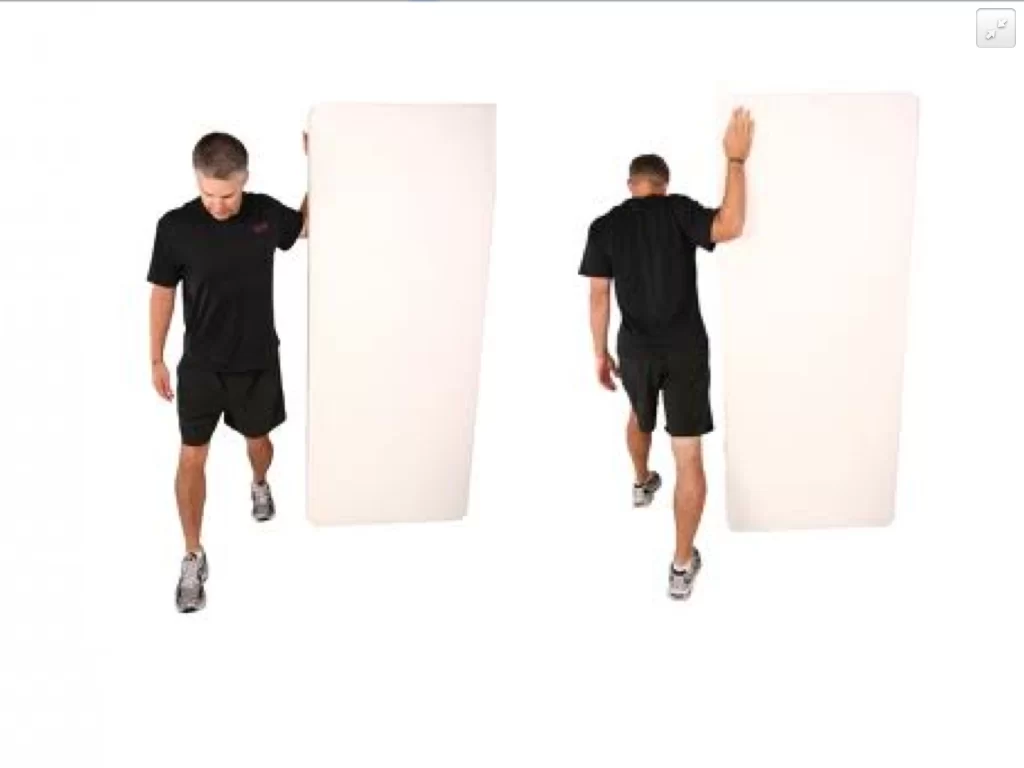
- Put your forearms on either side of the door frame as you stand in a doorway.
- Step forward with one foot, gently leaning your body forward until you feel a stretch in the front of your chest.
- Hold the pectoral muscle stretch for 15-30 seconds.
- Repeat the stretch 2-3 times.
Thoracic Extension:
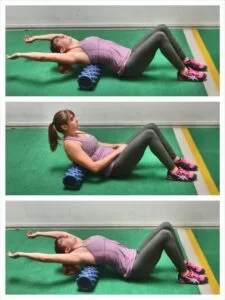
- Sit on a foam roller or a rolled-up towel, placing it horizontally along your upper back.
- Support your head with your hands, interlacing your fingers behind your head.
- Gently lean back over the foam roller, allowing it to provide support to your upper back.
- Hold the position for 15-30 seconds
- then return to the starting position.
- Repeat for 2-3 repetitions.
Nerve Gliding Exercises:
- These exercises involve specific movements to mobilize the nerves and promote their smooth gliding through the thoracic outlet. They should be performed gently and without causing pain. A physical therapist can guide you through these exercises, as they require proper technique and coordination.
Surgical Treatment
- Surgical treatment for costoclavicular syndrome is typically considered when conservative measures, such as physical therapy and medication, have failed to alleviate symptoms. There are several surgical options available, depending on the specific cause and severity of the condition. Here are a few examples:
- First Rib Resection: In cases where the compression is primarily caused by an abnormality or malformation of the first rib, a surgical procedure called first rib resection may be performed. During this surgery, the surgeon removes a portion or the entire first rib to relieve the compression on the nerves and blood vessels.
- Scalene Muscle Release: The scalene muscles, located in the neck, can sometimes contribute to the compression in the thoracic outlet. In scalene muscle release surgery, the surgeon cuts and releases the tight scalene muscles to relieve pressure on the nerves and blood vessels.
- Thoracic Outlet Decompression: This is a more comprehensive surgical approach that involves releasing or removing structures that are compressing the nerves and blood vessels in the thoracic outlet. The procedure may include the removal of the first rib, division of any fibrous bands, or excision of abnormal muscles or other structures causing compression.
FAQs
What is costoclavicular bra strap syndrome?
The compression of the costoclavicular passage: When wearing a very tight bra strap and/or cutting very sharply on the shoulders because they are really tight and can pinch veins and arteries around the neck and shoulders. It is especially common in women who are obese, with large breasts, or the elderly.
How do you increase costoclavicular space?
Encouraging diaphragmatic breathing helps to reduce and increase the activity of these muscles
costclavicular space. Vigorous aerobic activity can increase scalene activity and the first height
rib, so careful use of aerobic activities can help reduce symptoms, especially in the early stages of the rehabilitation process
What is the function of the Costoclavicular?
The orientation of the costoclavicular ligament to the SC joint anchors the lower surface of the sternum end of the clavicle to the first rib and serves as the main restraint of the SC joint. The Subclavius???? muscle also role to provide joint stability.

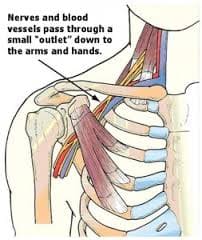
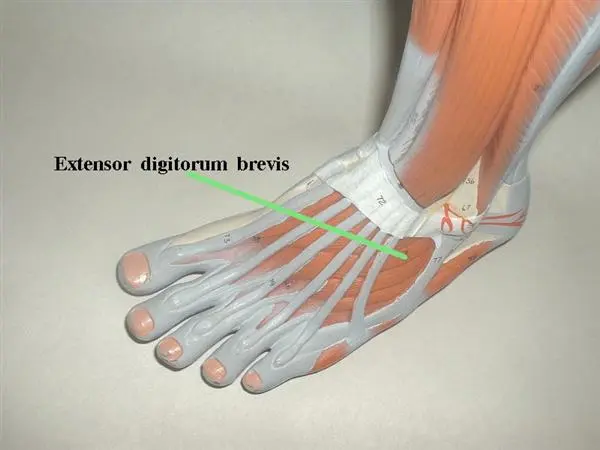
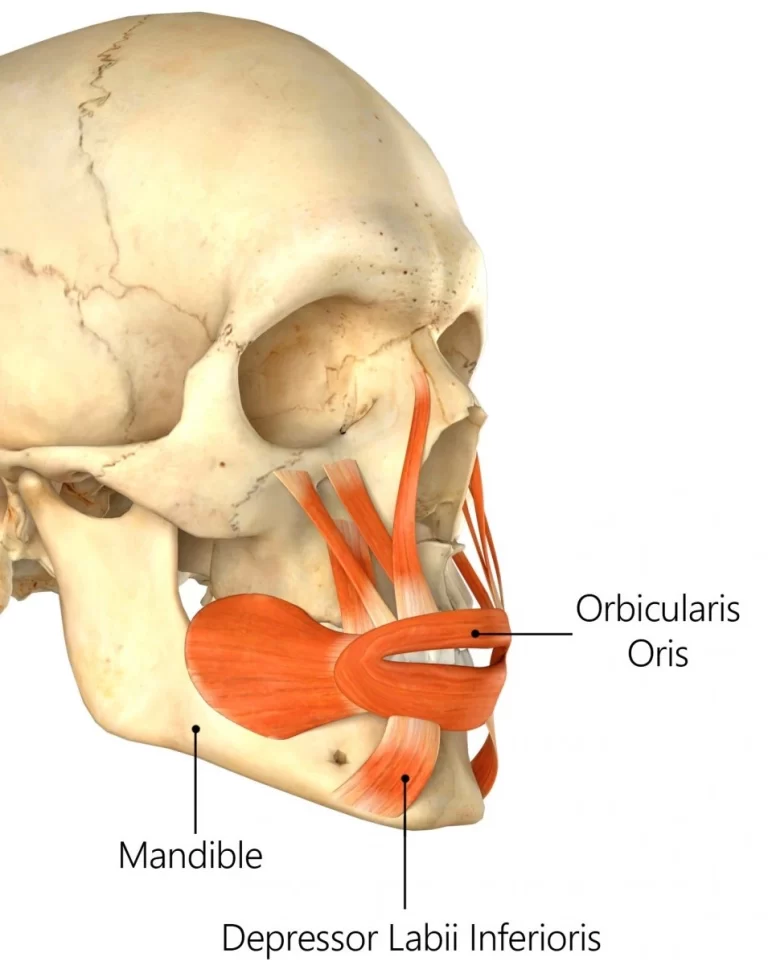
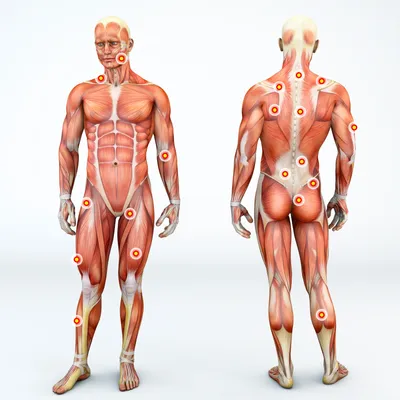

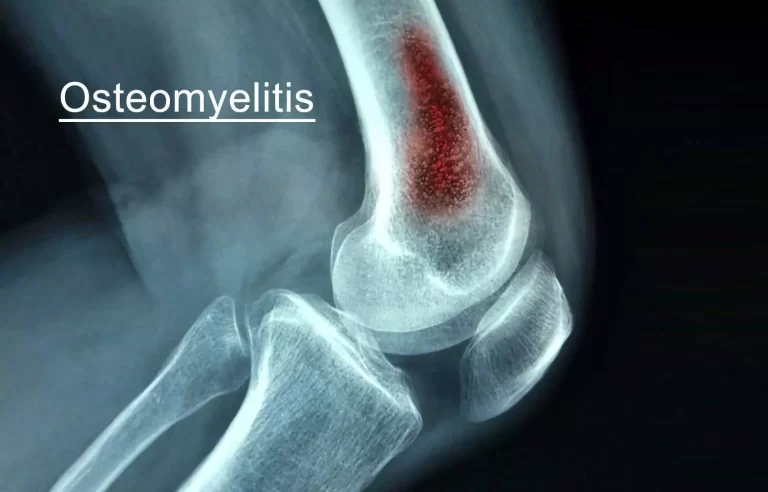
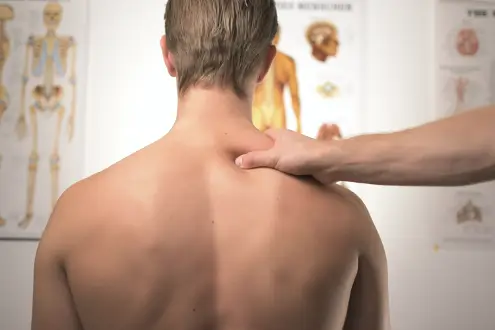
2 Comments